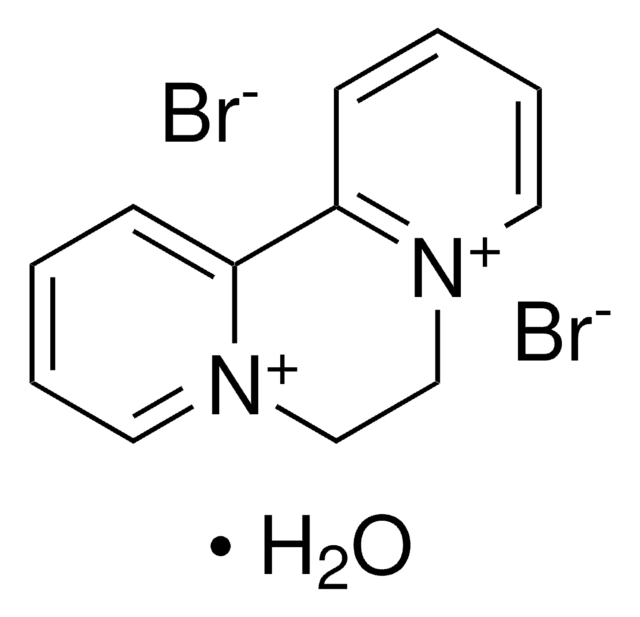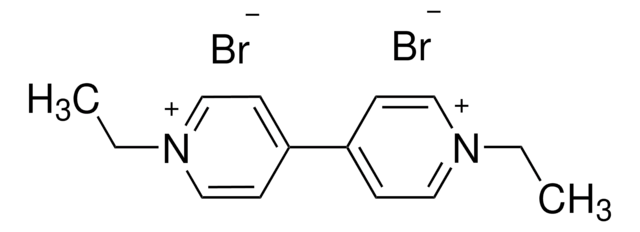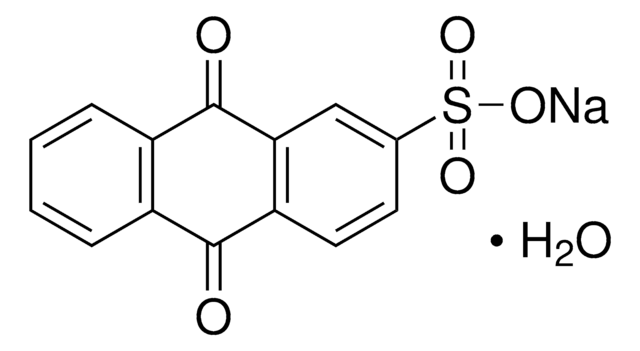856177
Methyl viologen dichloride hydrate
98%
Synonyme(s) :
1,1′-Dimethyl-4,4′-bipyridinium dichloride, Gramoxone, Paraquat dichloride
About This Item
Produits recommandés
Niveau de qualité
Essai
98%
Forme
solid
Pf
>300 °C (lit.)
Chaîne SMILES
[Cl-].[Cl-].[H]O[H].C[n+]1ccc(cc1)-c2cc[n+](C)cc2
InChI
1S/C12H14N2.2ClH.H2O/c1-13-7-3-11(4-8-13)12-5-9-14(2)10-6-12;;;/h3-10H,1-2H3;2*1H;1H2/q+2;;;/p-2
Clé InChI
RLGVBTFWTZJYIL-UHFFFAOYSA-L
Catégories apparentées
Description générale
Application
It can also be used as a mediator in the synthesis of ultrasmall bimetallic PdAg nanocatalysts.
Mention d'avertissement
Danger
Mentions de danger
Conseils de prudence
Classification des risques
Acute Tox. 2 Dermal - Acute Tox. 2 Inhalation - Acute Tox. 3 Oral - Aquatic Acute 1 - Aquatic Chronic 1 - Eye Irrit. 2 - Skin Irrit. 2 - STOT RE 1 - STOT SE 3
Organes cibles
Respiratory system
Code de la classe de stockage
6.1A - Combustible acute toxic Cat. 1 and 2 / very toxic hazardous materials
Classe de danger pour l'eau (WGK)
WGK 3
Point d'éclair (°F)
Not applicable
Point d'éclair (°C)
Not applicable
Équipement de protection individuelle
dust mask type N95 (US), Eyeshields, Faceshields, Gloves, type P2 (EN 143) respirator cartridges
Faites votre choix parmi les versions les plus récentes :
Déjà en possession de ce produit ?
Retrouvez la documentation relative aux produits que vous avez récemment achetés dans la Bibliothèque de documents.
Articles
Light-Emitting Polymers
Graphene has emerged as the new wonder material. Being only one atom thick and composed of carbon atoms arranged in a hexagonal honeycomb lattice structure, the interest in this material has exploded exponentially since 2004 when it was first isolated and identified using a very simple method.
Global Trade Item Number
| Référence | GTIN |
|---|---|
| 856177-1KG | |
| 856177-500G | |
| 856177-1G | 4061835563982 |
| 856177-250MG | 4061835571949 |
| 856177-5G |
Notre équipe de scientifiques dispose d'une expérience dans tous les secteurs de la recherche, notamment en sciences de la vie, science des matériaux, synthèse chimique, chromatographie, analyse et dans de nombreux autres domaines..
Contacter notre Service technique










